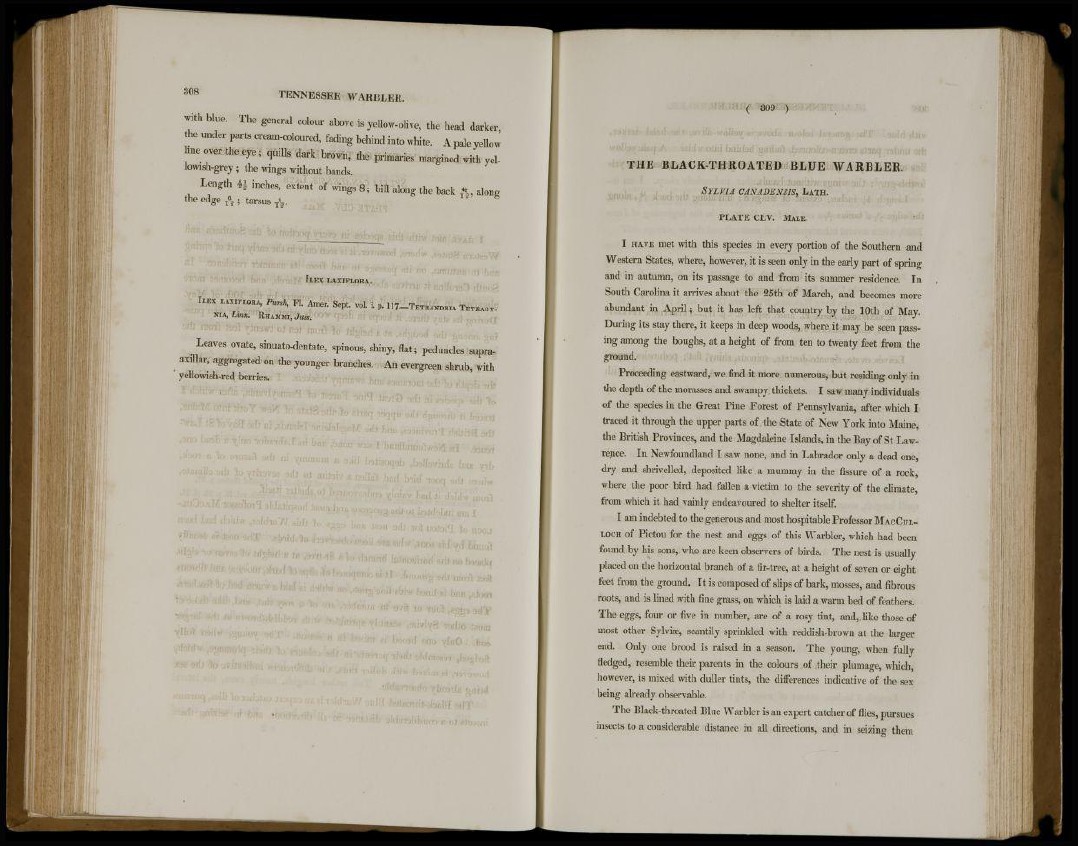
308 TENNESSEE WARBLER.
with blue. The general colour above is yellow-olive, the head darker,
the under parts cream-coloured, fading behind into white. A pale yellow
line over the eye ; quills dark brown, the primaries margined with yellowish
grey ; the wings without bands.
Length 4>l inches, extent of wings 8; bill along the back along
the edge T°g ; tarsus T
8
7 .
ILEX LAXIFLORA.
ILEX LAXIFLOIIA, Pursh, Fl. Amer. Sept. vol. i. p. 117—TETRANDRIA TETRAGYNIA,
Linn. EHAMMI, Jtiss.
Leaves ovate, sinuato-dentate, spinous, shiny, flat; peduncles supraaxillar,
aggregated on the younger branches. An evergreen shrub, with
yellowish-red berries.
THE BLACK-THROATED BLUE WARBLER.
SYLVIA CANADENSIS. LATH.
P L A T E CLV. MALE.
I HAVE met with this species in every portion of the Southern and
Western States, where, however, it is seen only in the early part of spring
and in autumn, on its passage to and from its summer residence. In
South Carolina it arrives about the 25th of March, and becomes more
abundant in April; but it has left that country by the 10th of May.
During its stay there, it keeps in deep woods, where it may be seen passing
among the boughs, at a height of from ten to twenty feet from the
ground.
Proceeding eastward, we find it more numerous, but residing only in
the depth of the morasses and swampy thickets. I saw many individuals
of the species in the Great Pine Forest of Pennsylvania, after which I
traced it through the upper parts of the State of New York into Maine,
the British Provinces, and the Magdaleine Islands, in the Bay of St Lawrence.
In Newfoundland I saw none, and in Labrador only a dead one,
dry and shrivelled, deposited like a mummy in the fissure of a rock,
where the poor bird had fallen a victim to the severity of the climate,
from which it had vainly endeavoured to shelter itself.
I am indebted to the generous and most hospitable Professor MACCULLOCH
of Pictou for the nest and eggs of this Warbler, which had been
found by his sons, who are keen observers of birds. The nest is usually
placed on the horizontal branch of a fir-tree, at a height of seven or eight
feet from the ground. It is composed of slips of bark, mosses, and fibrous
roots, and is lined with fine grass, on which is laid a warm bed of feathers.
The eggs, four or five in number, are of a rosy tint, and, like those of
most other Sylvias, scantily sprinkled with reddish-brown at the larger
end. Only one brood is raised in a season. The young, when fully
fledged, resemble their parents in the colours of their plumage, which,
however, is mixed with duller tints, the differences indicative of the sex
being already observable.
The Black-throated Blue Warbler is an expert catcher of flies, pursues
insects to a considerable distance in all directions, and in seizing them